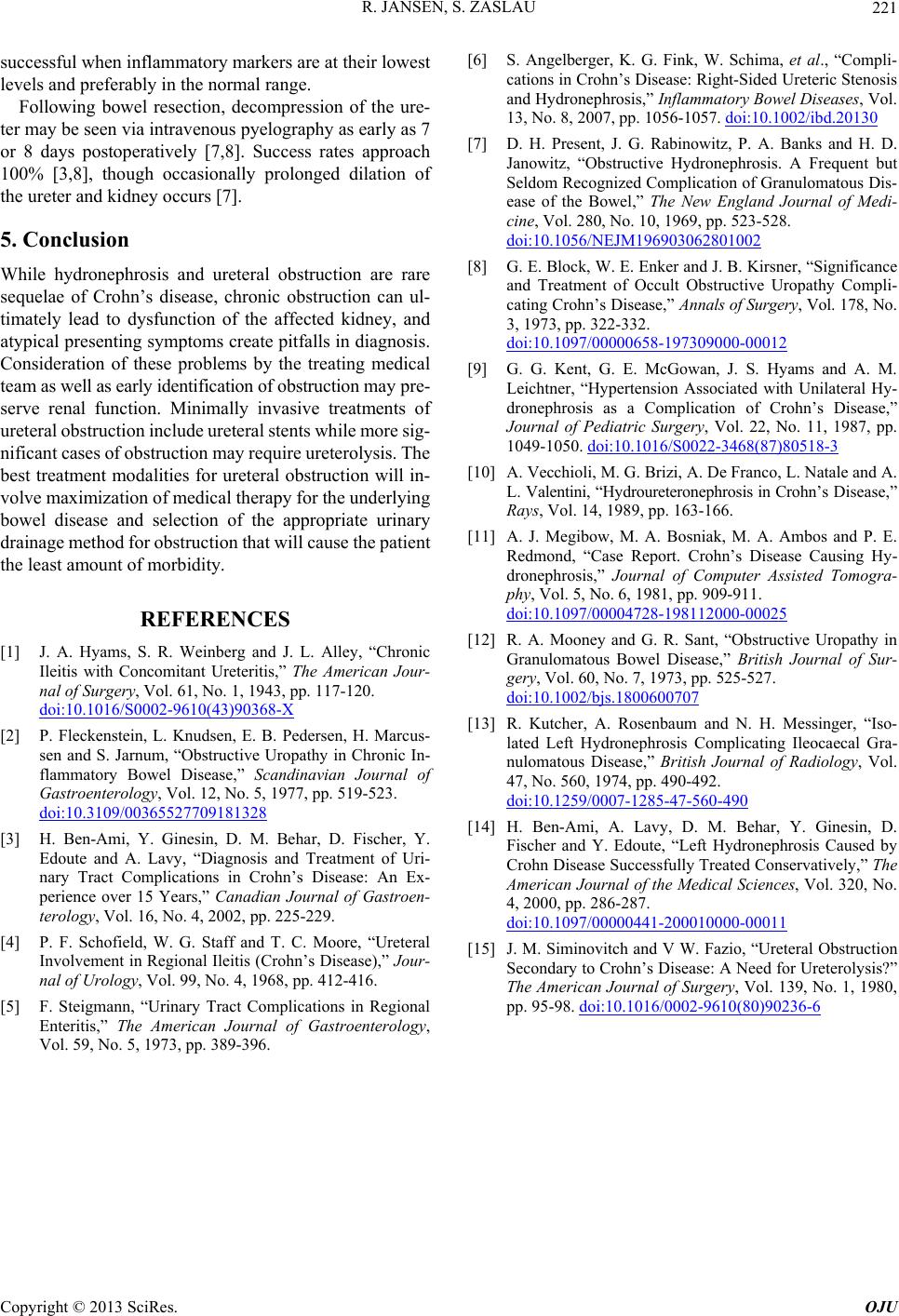
R. JANSEN, S. ZASLAU
Copyright © 2013 SciRes. OJU
221
successful when inflammatory markers are at their lowest
levels and preferably in the normal range.
Following bowel resection, decompression of the ure-
ter may be seen via intravenous pyelogr aphy as early as 7
or 8 days postoperatively [7,8]. Success rates approach
100% [3,8], though occasionally prolonged dilation of
the ureter and kidney occurs [7].
5. Conclusion
While hydronephrosis and ureteral obstruction are rare
sequelae of Crohn’s disease, chronic obstruction can ul-
timately lead to dysfunction of the affected kidney, and
atypical presenting symptoms create pitfalls in diagnosis.
Consideration of these problems by the treating medical
team as well as early identificati on of obstructi on may pre-
serve renal function. Minimally invasive treatments of
ureteral obstruction include uret eral stents while more sig-
nificant cases of obstruction may require ureterolysis. The
best treatment modalities for ureteral obstruction will in-
volve m axim i zati on of m edi cal t hera py fo r t he u nde rly ing
bowel disease and selection of the appropriate urinary
drainage method for obstruction that will cause the patient
the least amount of morbidity.
REFERENCES
[1] J. A. Hyams, S. R. Weinberg and J. L. Alley, “Chronic
Ileitis with Concomitant Ureteritis,” The American Jour-
nal of Surgery, Vol. 61, No. 1, 1943, pp. 117-120.
doi:10.1016/S0002-9610(43)90368-X
[2] P. Fleckenstein, L. Knudsen, E. B. Pedersen, H. Marcus-
sen and S. Jarnum, “Obstructive Uropathy in Chronic In-
flammatory Bowel Disease,” Scandinavian Journal of
Gastroenterology, Vol. 12, No. 5, 1977, pp. 519-523.
doi:10.3109/00365527709181328
[3] H. Ben-Ami, Y. Ginesin, D. M. Behar, D. Fischer, Y.
Edoute and A. Lavy, “Diagnosis and Treatment of Uri-
nary Tract Complications in Crohn’s Disease: An Ex-
perience over 15 Years,” Canadian Journal of Gastroen-
terology, Vol. 16, No. 4, 2002, pp. 225-229.
[4] P. F. Schofield, W. G. Staff and T. C. Moore, “Ureteral
Involvement in Regional Ileitis (Crohn’s Disease),” Jour-
nal of Urology, Vol. 99, No. 4, 1968, pp. 412-416.
[5] F. Steigmann, “Urinary Tract Complications in Regional
Enteritis,” The American Journal of Gastroenterology,
Vol. 59, No. 5, 1973, pp. 389-396.
[6] S. Angelberger, K. G. Fink, W. Schima, et al., “Compli-
cations in Crohn’s Disease: Right-Sided Ureteric Stenosis
and Hydronephrosis,” Inflammatory Bowel Diseases, Vol.
13, No. 8, 2007, pp. 1056-1057. doi:10.1002/ibd.20130
[7] D. H. Present, J. G. Rabinowitz, P. A. Banks and H. D.
Janowitz, “Obstructive Hydronephrosis. A Frequent but
Seldom Recognized Complication of Granulomatous Dis-
ease of the Bowel,” The New England Journal of Medi-
cine, Vol. 280, No. 10, 1969, pp. 523-528.
doi:10.1056/NEJM196903062801002
[8] G. E. Block, W. E. Enker and J. B. Kirsner, “Significance
and Treatment of Occult Obstructive Uropathy Compli-
cating Crohn’s Disease,” An nals of Surgery, Vol. 178, No .
3, 1973, pp. 322-332.
doi:10.1097/00000658-197309000-00012
[9] G. G. Kent, G. E. McGowan, J. S. Hyams and A. M.
Leichtner, “Hypertension Associated with Unilateral Hy-
dronephrosis as a Complication of Crohn’s Disease,”
Journal of Pediatric Surgery, Vol. 22, No. 11, 1987, pp.
1049-1050. doi:10.1016/S0022-3468(87)80518-3
[10] A. Vecchioli, M. G. Brizi, A. De Franco, L. Natale and A.
L. Valentini, “Hydroureteronephrosis in Crohn’ s Di seas e,”
Rays, Vol. 14, 1989, pp. 163-166.
[11] A. J. Megibow, M. A. Bosniak, M. A. Ambos and P. E.
Redmond, “Case Report. Crohn’s Disease Causing Hy-
dronephrosis,” Journal of Computer Assisted Tomogra-
phy, Vol. 5, No. 6, 1981, pp. 909-911.
doi:10.1097/00004728-198112000-00025
[12] R. A. Mooney and G. R. Sant, “Obstructive Uropathy in
Granulomatous Bowel Disease,” British Journal of Sur-
gery, Vol. 60, No. 7, 1973, pp. 525-527.
doi:10.1002/bjs.1800600707
[13] R. Kutcher, A. Rosenbaum and N. H. Messinger, “Iso-
lated Left Hydronephrosis Complicating Ileocaecal Gra-
nulomatous Disease,” British Journal of Radiology, Vol.
47, No. 560, 1974, pp. 490-492.
doi:10.1259/0007-1285-47-560-490
[14] H. Ben-Ami, A. Lavy, D. M. Behar, Y. Ginesin, D.
Fischer and Y. Edoute, “Left Hydronephrosis Caused by
Crohn Disease Successfully Treated Conservatively,” The
American Journal of the Medical Sciences, Vol. 320, No.
4, 2000, pp. 286-287.
doi:10.1097/00000441-200010000-00011
[15] J. M. Siminovitch and V W. Fazio, “Ureteral Obstruction
Secondary to Crohn’s Disease: A Need for Ureterolysis?”
The American Journal of Surgery, Vol. 139, No. 1, 1980,
pp. 95-98. doi:10.1016/0002-9610(80)90236-6